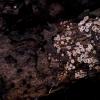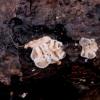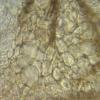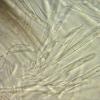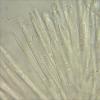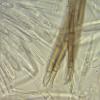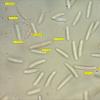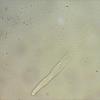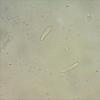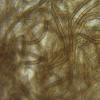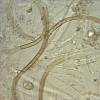
24-12-2025 17:08
Hulda Caroline HolteHello, I have found this propoloid ascomycete on

21-12-2025 09:32
Hello.A tiny ascomycete found embedded in wood in

21-12-2025 21:32
Pol DebaenstHello, Garden, Burgweg 19, Veurne, BelgiumOn 10/1

22-12-2025 23:38
Patrice TANCHAUDBonsoir, récolte sur un mur en pierre, apothéci

22-12-2025 00:47
Patrice TANCHAUDBonsoir, récolte à proximité du milieu dunaire
Lasiobelonium corticale?
William Slosse,
12-03-2017 15:59
 Could this be Lasiobelonium corticale?
Could this be Lasiobelonium corticale?I have a slight doubt because of the pointed paraphyses.
Thx for your meaning,
Willliam
Hans-Otto Baral,
12-03-2017 17:34

Re : Lasiobelonium corticale?
Hmm, the spores are regrettably too unsharp. Spore size would be o.k. but spore shape not so (should be more heteropolar), and spore contents also not (should be full of oil drops).
With a sharper spore photo this would be better to say.
With a sharper spore photo this would be better to say.
William Slosse,
13-03-2017 22:02

Re : Lasiobelonium corticale?
Thx for your remarks, Hans-Otto.
I toke a new sequence of pictures.
The free spores seems all to be not hyaline and scarcely filled with drops. Most of the free spores are germinating, perhaps that's a reason?
The spores into the asci seems to be filled with many drops.
Concerning the heteropolar shape, I must admit - eager to learn - that this doesn't ring a bell by me.
I hope this pictures are more usefull for you.
Regards, William
I toke a new sequence of pictures.
The free spores seems all to be not hyaline and scarcely filled with drops. Most of the free spores are germinating, perhaps that's a reason?
The spores into the asci seems to be filled with many drops.
Concerning the heteropolar shape, I must admit - eager to learn - that this doesn't ring a bell by me.
I hope this pictures are more usefull for you.
Regards, William
Hans-Otto Baral,
13-03-2017 22:26

Re : Lasiobelonium corticale?
Ah, what is also missing is the IKI reaction, sorry. Some species react red, others blue.
Heteropolar means that there the spores are attenuated towards the basal end, narrowly clavate. Not here.
The pic with the single large ascus shows non-septate spores with a few drops only. This ascus is alive and mature, and the spores within are representative.
You should also look at the hairs on the lower side, in order to exclude L. variegatum which has strongly flexuous hairs there.
Do you have any idea of the substrate?
Heteropolar means that there the spores are attenuated towards the basal end, narrowly clavate. Not here.
The pic with the single large ascus shows non-septate spores with a few drops only. This ascus is alive and mature, and the spores within are representative.
You should also look at the hairs on the lower side, in order to exclude L. variegatum which has strongly flexuous hairs there.
Do you have any idea of the substrate?
William Slosse,
13-03-2017 22:43

Re : Lasiobelonium corticale?
The substrate is an old branch of Salix cinerea in an very moist dunedepression.
Can I use Meltzer or KOH instead of IKI?
Can I use Meltzer or KOH instead of IKI?
Hans-Otto Baral,
14-03-2017 07:41

Re : Lasiobelonium corticale?
well, I should say no, but you can try WITHOUT KOH, and afterwards after KOH. If the result is very different (pale vs. deep blue) then we can conclude that it would react red in IKI.
William Slosse,
14-03-2017 22:50
Hans-Otto Baral,
15-03-2017 08:00

Re : Lasiobelonium corticale?
Yes indeed, these pics clearly point to L. variegatum!
William Slosse,
15-03-2017 20:13

Re : Lasiobelonium corticale?
Thx for the affirmation, Hans-Otto.
Seems to be a very rare species in our region!
Sincerely,
William
Seems to be a very rare species in our region!
Sincerely,
William
William Slosse,
15-03-2017 20:13

Re : Lasiobelonium corticale?
Thx for the affirmation, Hans-Otto.
Seems to be a very rare species in our region!
Sincerely,
William
Seems to be a very rare species in our region!
Sincerely,
William
Hans-Otto Baral,
15-03-2017 20:36

Re : Lasiobelonium corticale?
It is actually a common species, but I do not know its distribution.
